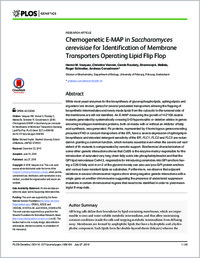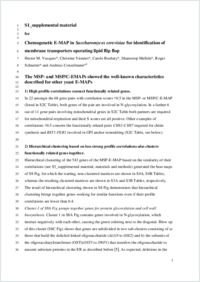Chemogenetic E-MAP in Saccharomyces cerevisiae for identification of membrane transporters operating lipid flip flop
- Vazquez, Hector M. Division of Biochemistry, Department of Biology, University of Fribourg, Fribourg, Switzerland
- Vionnet, Christine Division of Biochemistry, Department of Biology, University of Fribourg, Fribourg, Switzerland
- Roubaty, Carole Division of Biochemistry, Department of Biology, University of Fribourg, Fribourg, Switzerland
- Mallela, Shamroop K. Division of Biochemistry, Department of Biology, University of Fribourg, Fribourg, Switzerland
- Schneiter, Roger Division of Biochemistry, Department of Biology, University of Fribourg, Fribourg, Switzerland
- Conzelmann, Andreas Division of Biochemistry, Department of Biology, University of Fribourg, Fribourg, Switzerland
-
27.07.2016
Published in:
- PLOS Genet. - 2016, vol. 12, no. 7, p. e1006160
English
While most yeast enzymes for the biosynthesis of glycerophospholipids, sphingolipids and ergosterol are known, genes for several postulated transporters allowing the flopping of biosynthetic intermediates and newly made lipids from the cytosolic to the lumenal side of the membrane are still not identified. An E-MAP measuring the growth of 142'108 double mutants generated by systematically crossing 543 hypomorphic or deletion alleles in genes encoding multispan membrane proteins, both on media with or without an inhibitor of fatty acid synthesis, was generated. Flc proteins, represented by 4 homologous genes encoding presumed FAD or calcium transporters of the ER, have a severe depression of sphingolipid biosynthesis and elevated detergent sensitivity of the ER. FLC1, FLC2 and FLC3 are redundant in granting a common function, which remains essential even when the severe cell wall defect of flc mutants is compensated by osmotic support. Biochemical characterization of some other genetic interactions shows that Cst26 is the enzyme mainly responsible for the introduction of saturated very long chain fatty acids into phosphatidylinositol and that the GPI lipid remodelase Cwh43, responsible for introducing ceramides into GPI anchors having a C26:0 fatty acid in sn-2 of the glycerol moiety can also use lyso-GPI protein anchors and various base resistant lipids as substrates. Furthermore, we observe that adjacent deletions in several chromosomal regions show strong negative genetic interactions with a single gene on another chromosome suggesting the presence of undeclared suppressor mutations in certain chromosomal regions that need to be identified in order to yield meaningful E-map data.
- Faculty
- Faculté des sciences et de médecine
- Department
- Département de Biologie
- Language
-
- English
- Classification
- Biological sciences
- License
- License undefined
- Identifiers
-
- RERO DOC 277616
- DOI 10.1371/journal.pgen.1006160
- Persistent URL
- https://folia.unifr.ch/unifr/documents/305247
Other files
Statistics
Document views: 79
File downloads:
- con_cem.pdf: 123
- con_cem_sm.pdf: 91

